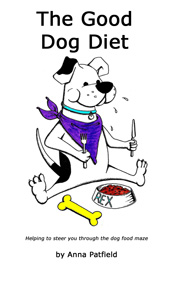How to choose which dog or puppy food to feed
These days, what to feed a dog can be a very difficult question. In fact, there is so much controversy and confusion, research becomes really very frustrating.
There are 2 questions to consider - Does Food Affect the Health of our Dogs AND Does Food Affect our Dog's Behaviour.
These days, information is so easy to come by. The problem is figuring out what we can trust. Advice from various web pages, from dog food companies, from those who work in dog businesses, our neighbours and people in pet shops varies hugely, and is often contradictory.
The big question in my mind, being a dog behaviourist, was why changing some dogs' food seems to help to fix their behaviour problems, whilst many thousands of dogs seemed to be just fine on that particular food. The result of years of study is The Good Dog Diet.
The Good Dog Diet

The food story begins with what food is, what it does, and how it gets into the right places in the body. It then looks at whether food actually affects behaviour - by looking at all of the things that can affect behaviour and thus providing the information needed to be able to judge if changing a dog's diet will help with the overall behaviour program. Next, as with most dog food books, the controversies are discussed to help to sort out fact from fiction. And finally, there is a guide on how to go about determining how to change your dog's food.
What's in the book?
- not biased on one diet or the other
- what's important about food
- how it's digested
- what affects behaviour
- how could food affect behaviour
- sorting out fact from fiction
- how to change a dog's diet
You can read more about The Good Dog Diet and purchase options here.
Here's are some quick tips to help you choose the right food for your dog or puppy.
The most important points are
- the food that your dog eats must be nutritionally balanced to ensure the best levels of health (and happiness)
- it must suit them as an individual
- they must like it enough to eat enough of it to take in all the nutrients that they need
- the food should be best selected to be the best you can afford to feed (the best doesn't necessarily mean the most expensive food).
Types of food to feed your dog are
- commercially prepared dry food
- commercially prepared wet / tinned or sachet food
- home cooked food
- raw food
The answer on which to choose really boils down to whether you want to spend time reading up on reliable sources regarding how best to mix the ingredients that you might want to put into a home prepared food; or whether you're happy with feeding a commercially prepared dog food.
Commercially prepared food sometimes gets a bad press. The benefit of using it though, is that someone has sat down and spent the time to ensure that all the vitamins and minerals, proteins, carbohydrates and fats are all there, in the correctly balanced quantities. So if you're happy trusting that, then -
- Have a look at the company you're choosing on the web
- Read the label! We all do this much more now on the foods we buy in the supermarket, but rarely do we actually look at the dog food labels. When reading the ingredients then, the chances are that if you recognise the first half dozen ingredients, and would put them on your own plate, then it's probably a reasonable food - but- there are exceptions!
If you want to feed raw or cooked, then please ensure that you are feeding a nutritionally balanced diet. Read more at Monica Segal's site and see her book for recipes.
Please note: The only person who is legally allowed to instruct you on what to feed your dog is your vet.
If you want to know more about how best to feed your dog for health and happiness, then please do have a look at The Good Dog Diet.
Go to Dog Training Notes | Puppy Training Notes